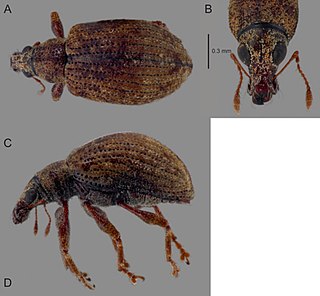
Plumeria, also known as frangipani, is a genus of flowering plants in the subfamily Rauvolfioideae, of the family Apocynaceae. Most species are deciduous shrubs or small trees. The species are native to the Neotropical realm, but are often grown as cosmopolitan ornamentals in tropical regions, especially in Hawaii, as well as hot desert climates in the Arabian Peninsula with proper irrigation.
Lasiocroton is a plant genus of the family Euphorbiaceae first described as a genus in 1859. The genus is endemic to the West Indies. It is a member of the Leucocroton alliance, which also includes Leucocroton and Garciadelia. Species in this alliance are dioecious.
- Lasiocroton bahamensisPax & K.Hoffm. - Bahamas, Cuba, Haiti
- Lasiocroton fawcettiiUrb. - Jamaica
- Lasiocroton gracilisBritton & P.Wilson - SE Cuba
- Lasiocroton gutierreziiJestrow - Cuba
- Lasiocroton harrisiiBritton - Jamaica
- Lasiocroton macrophyllus(Sw.) Griseb. - Jamaica
- Lasiocroton microphyllus(A.Rich.) Jestrow - Cuba
- moved to other genera (Bernardia Croton Leucocroton)
- Lasiocroton cordifoliusBritton & P.Wilson - Leucocroton cordifolius (Britton & P.Wilson) Alain
- Lasiocroton prunifoliusGriseb. - Croton punctatusJacq.
- Lasiocroton subpeltatusUrb. - Leucocroton subpeltatus(Urb.) Alain
- Lasiocroton trelawniensisC.D.Adams - Bernardia trelawniensis(C.D.Adams) Jestrow & Proctor
Bonania is a plant genus of the family Euphorbiaceae first described as a genus in 1850. It is native to the West Indies.
- Bonania cubanaA.Rich. - Bahamas, Cuba
- Bonania domingensis(Urb.) Urb. - Haiti, Dominican Rep
- Bonania ellipticaUrb. - Cuba
- Bonania emarginataC.Wright ex Griseb. - Cuba
- Bonania erythrosperma(Griseb.) Benth. & Hook.f. ex B.D.Jacks. - Cuba
- Bonania linearifoliaUrb. & Ekman - Haiti
- †Bonania myricifolia(Griseb.) Benth. & Hook.f. - Guantánamo but extinct

Pimenta is a genus of flowering plants in the myrtle family, Myrtaceae described as a genus in 1821. It is native to Central and South America, Mexico, and the West Indies.

Sideroxylon is a genus of trees in the family Sapotaceae described as a genus by Linnaeus in 1753. They are collectively known as bully trees. The generic name is derived from the Greek words σιδηρος (sideros), meaning "iron", and ξύλον (xylon), meaning "wood."

Pithecellobium is a genus of flowering plants in the family Fabaceae. It includes approximately 23 species from the tropical Americas, ranging from Mexico to Peru and northern Brazil, including the Caribbean Islands and Florida.

Koanophyllon is a genus of plants in the family Asteraceae. They are perennials and shrubs and are native to South America, Central America, the West Indies, Mexico, with a few species range extending into the United States. The flowers are white to pinkish.

Casasia is a genus of flowering plants in the family Rubiaceae. These shrubs or small trees occur on the Caribbean islands and in one case in Florida. Some of the ten accepted species were formerly placed elsewhere, e.g. in the related genip-tree genus (Genipa), in Gardenia or in Randia.

Ginoria is a genus of plants in the family Lythraceae. It contains 13 species which are native to southern Mexico and the Caribbean.

Wallenia is a genus of flowering plants in the family Primulaceae endemic to the West Indies. It is composed of 29 species. It also includes a subgenus, Homowallenia, with ten species from the northern Caribbean.
The Caribbean bioregion is a biogeographic region that includes the islands of the Caribbean Sea and nearby Atlantic islands, which share a fauna, flora and mycobiota distinct from surrounding bioregions.
Lantanopsis is a genus of Caribbean flowering plants in the family Asteraceae.

Chaptalia is a genus of flowering plants in the family Asteraceae.

Tetramicra is a genus of flowering plants in the orchid family, Orchidaceae, native to the West Indies. Tetramicra canaliculata has also been reported from southern Florida, but these reports have been challenged. Tetramicra is abbreviated Ttma. in the horticultural trade.

Ernodea is a genus of flowering plants in the family Rubiaceae. All species are small shrubs endemic to the Caribbean region, with most species restricted to the Bahamian Archipelago.

Catesbaea is a genus of flowering plants in the family Rubiaceae. It occurs in the West Indies, The Bahamas, and the Florida Keys. The genus is named in honour of English naturalist Mark Catesby.

Thouinia is a genus of flowering plants in the family Sapindaceae. The genus is named for André Thouin, a French botanist. As of 2020 Kew's Plants of the World Online lists 27 species in the genus:
Pseudocarpidium is a genus of flowering plants in the family Lamiaceae first described in 1906. It is native the West Indies.
- Pseudocarpidium avicennioides(A.Rich.) Millsp. - eastern Cuba
- Pseudocarpidium domingense(Urb. & Ekman) Moldenke - Hispaniola
- Pseudocarpidium ilicifolium (A.Rich.) Millsp. - Cuba
- Pseudocarpidium multidens(Urb.) Moldenke - eastern Cuba
- Pseudocarpidium neglectaBisse - Cuba
- Pseudocarpidium pungensBritton - eastern Cuba
- Pseudocarpidium rigens(Griseb.) Britton - eastern Cuba
- Pseudocarpidium shaferiBritton - eastern Cuba
- Pseudocarpidium wrightiiMillsp. - Bahamas, Cuba

Heterosavia is a genus of the family of Phyllanthaceae first described as a genus in 2008. It is native to the Caribbean and southern Florida. It is found in Bahamas, Cayman Islands, Cuba, Dominican Republic, Florida, Haiti, Jamaica, southwest Caribbean and Turks-Caicos Islands.

Apodrosus is a Caribbean genus of broad-nosed weevils in the subfamily Entiminae, tribe Polydrusini.














